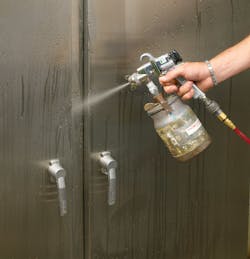Enclosures: Critical Specification Factors
April 23, 2012
7 min read
All too often, serious discussion about the cabinet that will house the control and communication devices that comprise an automated system rarely takes place. This is not to say that no consideration is given to control cabinet specification. It’s just that, in many cases, all the factors that should be considered are not always brought to the table.
This article, compiled with information provided by Hoffman, an enclosure supplier based in Anoka, MN, looks at the primary issues that should be a part of any discussion about proper housing for control equipment.
Environmental Factors
Most people would agree that application environmental factor considerations are top of mind when it comes to control system cabinets. From forms and presence of liquid and airborne particulates to wide temperature variations to ultraviolet (UV) rays, environmental elements and conditions can have a significant impact on how an enclosure will perform over years of operation.
Specifiers and purchasers must also take into consideration whether the enclosure, in its application, will be located indoors or outdoors; exposed to wash down or direct sunlight; or be subject to the effects of harsh chemicals or corrosive agents.
Of the many environmental issues to consider, the effects of temperature on components will often find its way to the top of the list. Non-metallic enclosures, such as those made of polycarbonate or polyester, provide great insulation while metallic, such as stainless steel, absorb and conduct heat. If heat dissipation is a concern, a metallic enclosure will typically dissipate heat better than a non-metallic enclosure. Several thermal management solutions are available to address heat concerns, including passive options such as paint color changes or louvers and active options such as filter fans, heat exchangers and air conditioners.
Another application issue to consider is installation location, such as high on a pole or in a high-traffic accessible area. The installation location may also have electromagnetic, radio frequency interference or wireless transmission requirements. Accessibility and security also need to be considered, and can be solved through various latching or locking options.
Material and finish choice is also an important decision. Different materials affect weight impact resistance and strength, and corrosion performance.
Standards
Four of the most commonly recognized certification agencies that enclosures are certified with include, the International Electrotechnical Commission (IEC), which is based in Europe and accepted globally, Canadian Standards Association (CSA) for Canadian market, Underwriters Laboratories (UL) and National Electrical Manufacturer’s Association (NEMA) for the North American market. The corresponding standards published by these agencies are IEC 60529, CSA C22.2 No. 94.1 and 94.2, UL 50, 50E, and 508A, and NEMA 250.
IEC 60529 includes a list of requirements with two number codes used to identify ingress protection levels. Commonly referred to as the IP rating, these codes reflect an electrical enclosure’s ability to protect against access to electrified parts by people, tools, liquid, dust or dirt. IP ratings do not cross directly to NEMA, CSA and UL Type ratings. For example, some IP ratings allow a minimal amount of dust or water to enter an enclosure as long as the ingress does not interfere and compromise the performance of the electrical and electronic equipment inside the enclosure.
The NEMA 250 standard is the basis for UL 50, 50E and CSA 22.2 No. 94.1 and 94.2. While the enclosure construction requirements and performance Type Ratings are the same for NEMA, UL and CSA, NEMA compliance is self declared by the manufacturer, while UL and CSA require approval of testing and manufacturing inspection.
Gaskets
The often overlooked enclosure gasket performs the critical task of preventing the infiltration of dust, liquids and contaminants, as well as EMI and RFI penetration in EMC applications. Many different tests are conducted on gasket materials to verify suitability for intended application and compliance to the Type and IP performance ratings. The gasket is the most critical component for maintaining the enclosure seal, and it must be maintained to ensure proper protection.
To ensure that gaskets provide necessary levels of protection, the enclosure Type ratings include the following tests:
• Type 12: dripping water and circulation of concrete dust or atomized water spray;
• Type 13: 2 gallons per minute of a water/wetting agent mix for 30 minutes;
• Type 3: concrete dust is circulated around the enclosure and hose tested;
• Type 3R: 3 spray nozzles each producing 5 psi of water spray for 1 hour;
• Type 4, 4X: 65 gallons per minute hosedown for a minimum of 5 minutes from 10-12 feet;
• Type 6: temporary submersion in 6 feet of water for 30 minutes; and
• Type 6P: temporary submersion in 6 feet of water for 24 hours.
For indoor applications, a gasket with a UL Type rating of 12 or 13 is typically recommended. Type 3, 4, 4X, 6 and 6P rated gaskets are commonly used for outdoor applications. While Type 3, 4, 4X, 6 and 6P rated enclosures can also be used in indoor applications, these enclosures are typically more expensive than Type 12 or 13 enclosures.
Modifications
Since it is not uncommon for enclosures to be modified in the field, specifiers should consider the ease and modification flexibility of an enclosure material in their design criteria.
Thermoplastics or other non-glass filled polymeric materials are highly suitable for jobsite modifications. Fiberglass reinforced polyester is slightly more difficult to modify due to the glass strands contained being highly abrasive and not conducive to clean cutouts. In regards to metal enclosures, aluminum is fairly easy to cut and saw, mild steel is more difficult, but can be modified with standard hand tools. Stainless steel is difficult to cut and requires special tools and lubrication to provide clean holes and cutouts.
Condensation
Condensation results when moist air is cooled or comes into contact with a cool surface that is at or below its saturation point, also called its dew point. Needless to say, condensation can be a big problem for the electronics inside a control cabinet.
When water pools in the enclosure bottom as a result of condensation, users have been known to employ several methods to deal with this issue. Some of these methods include wiping with a towel; using light bulbs to raise the temperature, which also allows the air to hold more water; and even drilling a small hole in the bottom of the enclosure and mounting the enclosure at a slant to direct water towards the opening. While a drilled hole can be an effective way to drain the enclosure, it compromises the enclosure performance Type rating, and does not address the issue of moisture on the components themselves. The drilled hole allows humid air and water to re-enter through the very holes that were introduced to rid the enclosure of water, creating a continuous cycle of condensation.
Another common solution used for dealing with condensation is the use of drains and breathers that provide the functionalities of draining and pressure equalization, but most of these devices are only certified for hazardous location requirements, but are not UL and CSA certified to maintain the enclosure UL and CSA Type rating. These devices typically will not pass a UL, CSA or NEMA Type 4 water hose down test. Drains and breathers alone do not address the real problem of condensation on components and the related performance and corrosion issues. To deal with this issue, look for a condensate management solution that addresses the real issue of moisture that would include a UL 508A certified drain in combination with a device that can actually pull moisture out of the air inside a sealed enclosure.
For an example of an enclosure that was designed to accommodate a variety of environmental conditions, see the video below of the Hoffman WeatherFlo HD — an enclosure designed for protecting and cooling variable frequency drives in indoor or outdoor (UL Type 3R) applications.
About the Author
David Greenfield, editor in chief
Editor in Chief
David Greenfield joined Automation World in June 2011. Bringing a wealth of industry knowledge and media experience to his position, David’s contributions can be found in AW’s print and online editions and custom projects. Earlier in his career, David was Editorial Director of Design News at UBM Electronics, and prior to joining UBM, he was Editorial Director of Control Engineering at Reed Business Information, where he also worked on Manufacturing Business Technology as Publisher.
Sign up for our eNewsletters
Get the latest news and updates

Leaders relevant to this article:

